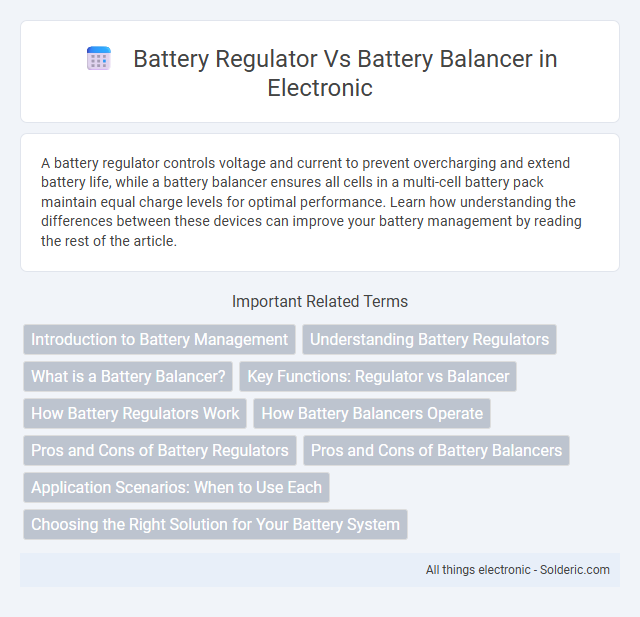A battery regulator controls voltage and current to prevent overcharging and extend battery life, while a battery balancer ensures all cells in a multi-cell battery pack maintain equal charge levels for optimal performance. Learn how understanding the differences between these devices can improve your battery management by reading the rest of the article.
Comparison Table
| Feature | Battery Regulator | Battery Balancer |
|---|---|---|
| Purpose | Controls charging voltage to protect battery | Equalizes voltage across multiple battery cells |
| Function | Prevents overcharging and deep discharging | Balances state of charge among battery cells |
| Common Use | Solar power systems, automotive batteries | Battery packs with series-connected cells (e.g., Li-ion) |
| Operation | Limits input voltage to safe battery levels | Transfers energy between cells to equalize voltage |
| Key Benefit | Extends battery lifespan by preventing damage | Improves battery performance and longevity |
| Complexity | Simple voltage control | Advanced cell monitoring and energy transfer |
| Examples | MPPT charge controllers, PWM regulators | Passive balancers, active balancers |
Introduction to Battery Management
Battery regulators control voltage and current to ensure batteries charge safely and efficiently, preventing overcharging and extending battery lifespan. Battery balancers equalize voltage levels across cells in multi-cell battery packs, improving performance and preventing damage from cell imbalances. Both components are crucial in battery management systems for maintaining optimal battery health and maximizing energy storage reliability.
Understanding Battery Regulators
Battery regulators control the voltage and current supplied to a battery, ensuring safe charging by preventing overcharging and excessive discharge. They maintain optimal battery health through precise voltage regulation, which enhances longevity and performance. Unlike battery balancers, which equalize charge across cells, battery regulators focus on overall charge management and protection.
What is a Battery Balancer?
A Battery Balancer is a device designed to equalize the voltage across individual cells within a multi-cell battery pack, preventing overcharging and undercharging of any single cell. It ensures optimal battery performance and longevity by maintaining uniform charge levels, reducing the risk of cell damage and capacity loss. Your battery system benefits from improved safety and efficiency through consistent voltage balancing.
Key Functions: Regulator vs Balancer
Battery regulators primarily control voltage and current to prevent overcharging and protect battery health, ensuring stable and safe charging conditions. Battery balancers equalize the charge levels among individual cells within a battery pack, optimizing capacity utilization and extending overall battery lifespan. While regulators maintain safe operating parameters, balancers enhance performance by maintaining uniform cell voltage distribution.
How Battery Regulators Work
Battery regulators control voltage and current to maintain safe charging levels, preventing overcharging and damage to the battery. They actively adjust the power flow by monitoring battery voltage and temperature, ensuring optimal performance and longevity. This precise regulation protects battery health in various applications, from solar power systems to electric vehicles.
How Battery Balancers Operate
Battery balancers operate by equalizing the voltage levels across battery cells to ensure uniform charge distribution and prevent overcharging or undercharging of individual cells. They actively transfer energy from higher-voltage cells to lower-voltage cells, maintaining balance and extending the overall battery pack lifespan. Unlike battery regulators that control charging and discharging rates, balancers focus specifically on maintaining cell voltage equilibrium within multi-cell battery systems.
Pros and Cons of Battery Regulators
Battery regulators efficiently maintain a stable voltage level to prevent battery overcharging, enhancing battery lifespan and system reliability, but they may not address cell imbalances within multi-cell battery packs. Their simplicity and cost-effectiveness make them ideal for basic battery management systems, yet they lack the precision of battery balancers in optimizing individual cell voltages. Battery regulators provide essential protection but can lead to reduced overall performance if cell imbalances remain uncorrected.
Pros and Cons of Battery Balancers
Battery balancers improve the lifespan and efficiency of battery banks by equalizing voltage across individual cells, preventing overcharging and undercharging. They are highly effective in maintaining battery health during parallel charging but may add complexity and cost to the system. However, battery balancers can sometimes cause slight energy losses and require careful installation to avoid potential malfunctions.
Application Scenarios: When to Use Each
Battery regulators are best used in applications where voltage control is critical to protect batteries from overcharging or deep discharge, such as in solar power systems or electric vehicles. Battery balancers are essential in setups with multiple battery cells, like lithium-ion packs, to ensure even charge distribution and prevent cell imbalance that can reduce battery lifespan. Your choice depends on whether you need precise voltage regulation or uniform cell balancing in your battery management system.
Choosing the Right Solution for Your Battery System
Battery regulators control voltage and current to prevent overcharging and extend battery life, ensuring safe and efficient operation. Battery balancers maintain equal charge levels across individual cells, optimizing performance and preventing capacity loss in multi-cell battery packs. Choosing the right solution depends on whether your priority is overall battery protection or cell-level charge management to maximize your battery system's longevity and reliability.
Battery regulator vs battery balancer Infographic

 solderic.com
solderic.com